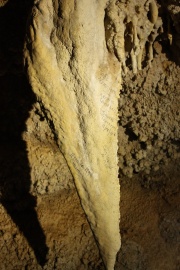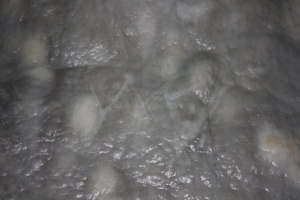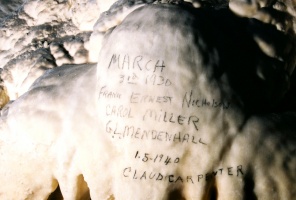Graffiti (Inventory)
From LagWiki
(Move the gallery) |
|||
| (16 intermediate revisions not shown) | |||
| Line 1: | Line 1: | ||
| - | The ''' | + | {{Inventory image|File:Historic graffiti, Black.JPG|Historic graffiti in the form of pencil marks on a stalactite}} |
| + | The '''Graffiti''' field should be used to list stations which exhibit some type of intentional human made marking. [[Graffiti (Inventory)/Pictographs|Pictographs]] have their own field. The medium for these marks could be: pencil, pen, paint, carbide, scratches in calcite, mud or clay and any number of other media. Graffiti marks tend to be signatures or initials or some type of identifying mark and often include a date but not necessarily. The markings may be historic or not depending upon their age and significance. When looking for graffiti marks, pay particular attention around the deepest areas of the cave near dead ends especially if the area is large enough in which to sit or stand comfortably. These types of locations seem to attract graffiti. Pictographs are more often found in the twilight areas; but, graffiti is common there, too. | ||
On the ''CCNP Cave Inventory Form'', the [[Recorder (Inventory)|recorder]] is asked to include a description and approximate age for all graffiti. Include this information next to the station. If the mark seems historic, recent or significant, a photograph could be helpful. | On the ''CCNP Cave Inventory Form'', the [[Recorder (Inventory)|recorder]] is asked to include a description and approximate age for all graffiti. Include this information next to the station. If the mark seems historic, recent or significant, a photograph could be helpful. | ||
==Example== | ==Example== | ||
| - | *Graffiti: <u> | + | *Graffiti: <u>FA79 (historic pencil signatures including "Robt Nymeyer" dated 1939)</u> |
| - | == | + | ==References== |
| - | *[[ | + | *Hildreth-Werker, Val and Werker, Jim C. (2006) ''Cave Conservation and Restoration'' National Speleological Society, Huntsville, AL pp 110,333-334 ISBN: [[Special:Booksources/1-879961-15-6|1-879961-15-6]] |
| - | *[[ | + | |
| + | ==Graffiti== | ||
| + | <gallery perrow=1 widths=300px heights=200px> | ||
| + | File:Graffiti scratches.JPG|Graffiti in the form of scratches on calcite flowstone | ||
| + | File:1930_Nicholson_Signatures.jpg|Historic graffiti signatures | ||
| + | </gallery> | ||
| + | |||
| + | ==Fields== | ||
| + | *[[Graffiti (Inventory)/Pictographs|Pictographs]] | ||
| + | *[[Graffiti (Inventory)/Other|Other]] | ||
{{Cave inventory}} | {{Cave inventory}} | ||
Current revision as of 02:03, 10 August 2013
The Graffiti field should be used to list stations which exhibit some type of intentional human made marking. Pictographs have their own field. The medium for these marks could be: pencil, pen, paint, carbide, scratches in calcite, mud or clay and any number of other media. Graffiti marks tend to be signatures or initials or some type of identifying mark and often include a date but not necessarily. The markings may be historic or not depending upon their age and significance. When looking for graffiti marks, pay particular attention around the deepest areas of the cave near dead ends especially if the area is large enough in which to sit or stand comfortably. These types of locations seem to attract graffiti. Pictographs are more often found in the twilight areas; but, graffiti is common there, too.
On the CCNP Cave Inventory Form, the recorder is asked to include a description and approximate age for all graffiti. Include this information next to the station. If the mark seems historic, recent or significant, a photograph could be helpful.
Contents |
Example
- Graffiti: FA79 (historic pencil signatures including "Robt Nymeyer" dated 1939)
References
- Hildreth-Werker, Val and Werker, Jim C. (2006) Cave Conservation and Restoration National Speleological Society, Huntsville, AL pp 110,333-334 ISBN: 1-879961-15-6
Graffiti
Fields



